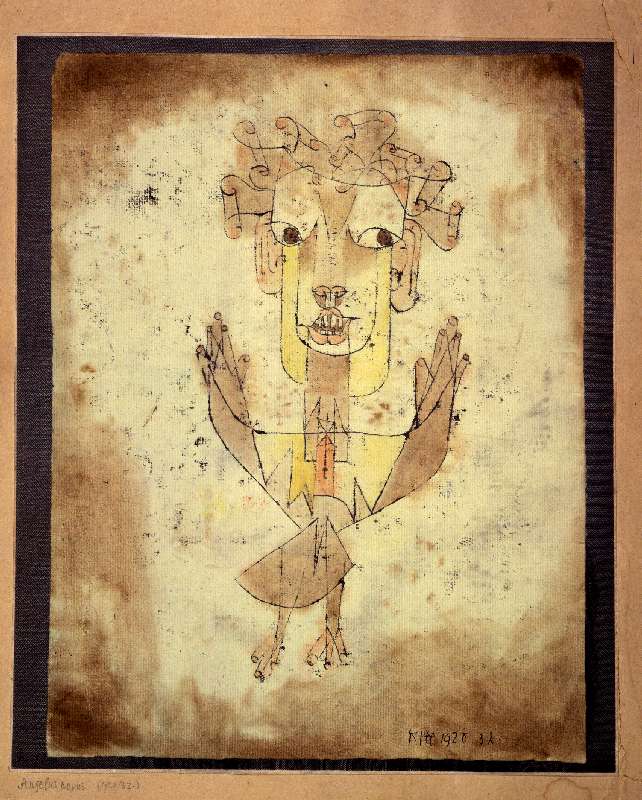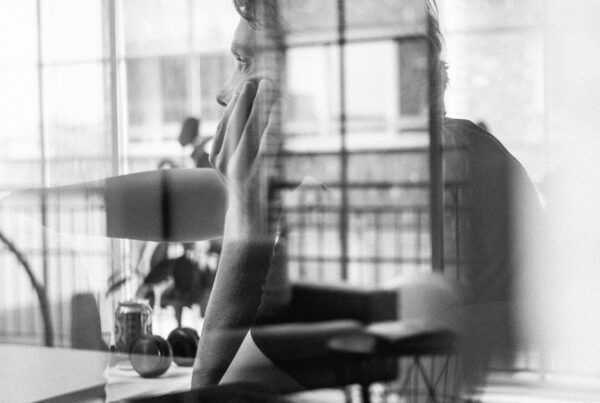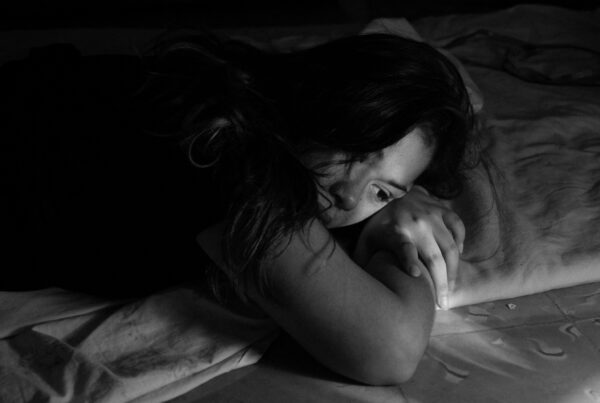
In a conversation concerning the purpose of art, one might try to evoke several great aestheticians like Winkelman or Hegel while they try to dismember the importance of artists and art production, but still silently wonder: does it really matter? Could its relevance be compared to the relevance of medicine or physics?
In a conversation concerning the purpose of art, one might try to evoke several great aestheticians like Winkelman or Hegel while they try to dismember the importance of artists and art production, but still silently wonder: does it really matter? Could its relevance be compared to the relevance of medicine or physics?

Angelus Novus by Paul Klee

Angelus Novus by Paul Klee
In the movie The Dead Poet Society, the professor attempts to teach the young students that art is what gives meaning to life, whereas the other noble professions like engineering and medicine seem to only maintain life. Assuming that this truly is the case, one might wonder why an art degree is still seen as a reason for ridicule. Or why, in most places of the world, one simply could not really sustain themselves by only being an artist. It is clear that there is a problem between art -as the alleged purpose of life- and art as an undermined societal phenomenon. For this reason, it is important to find theorists and arguments to back the purpose of art in human existence, after all, art does not seem to ever leave the side of the human condition.
Art production seems to rise again and again through human history, invoking something that Carl Jung described as the fundamental necessity to create. In this idea, being human entails the necessity to produce something, to leave a mark, to register oneself. This is a very interesting thought. It is especially interesting because it seems to focus on the artistic side of creation and give it instinctive properties. It does not seem to address only the idea of creating more comfort or progress through technology and research, but the actual desire to produce art. Jung mystically defined two opposite forces within the human condition and called them the anima and the animus. Disciple of Freud and coming from the psychoanalytic tradition, this great thinker knew little about evidence-based conclusions on the mind. It is in this realm of scientific scarcity that he conjures several symbols and several forces that guide humans and humanity. The anima is one of these internal symbols and it is the embodiment of the spirit of the feminine, nurture and creativity. The animus is the opposite force to the anima and it embodies the cold rational process of strategy, progress and the masculine. This dichotomous gender-role dynamic is inherently sexist and culturally biased. Therefore, the archetypes of animus and anima can perhaps only be useful in this piece if one can move past the masculine and feminine division and integrate both as inherently human parts, Jung did write that both the anima and animus were present in all humans.
“aesthetic judgement is something different from cognition, but no less real or important”
The anima within a person seems to shout and desire for the creation and appreciation of beauty, it seems to demand for not only a moral or cognitive judgement of the world, but also an aesthetic judgement of reality. Kant writes in the Critique of the Power of Judgement that aesthetic judgement is something different from cognition, but no less real or important. His argument is that the aesthetic side of things is liberating ‘because it appears after necessities are met’. One’s taste (or their appreciation for beauty) , in Kant’s eyes, is being satisfied with the object without morally or cognitively attaching oneself to it. One doesn’t need the beautiful object to be theirs or on their side to appreciate its beauty. It is not a competition or a game of strategy to prove one’s thesis correct, it’s simply being satisfied.
Great minds throughout history have written about art and about how different art is from anything else, but that is not all. The average person has also been fascinated by art through time, and for this reason, researching art and the human-art interaction is a very fruitful endeavour. However, research does not exhaust the art-human interaction. Jung would think: research is an act of the animus, and the anima should be respected when in the artistic act. It is necessary to talk about it, and reflect upon it, and discuss it through all means possible, be that a scientific journal or a conversation in a bar, or even a psychology student magazine.
Art rises as an ancient companion of the human condition, being with us through history, being recycled, changing, being restricted and being expanded; symbolizing power and symbolizing weakness. Harassing races and healing wounds. And in this, art fits in the analysis by Walter Benjamin of the piece Angelus Novus by Paul Klee. Klee was an abstractionist, fascinated by colors and psychological themes. He generously dabbled in many of the modernist movements, like cubism and surrealism, and created, with multiple mediums, the Angelus Novus. A confusing and unintuitive representation of an angel, which caught the attention of Walter Benjamin, a thinker associated with the Frankfurt School. Benjamin has a small manuscript, “On the Concept of History”, and there he mentions Klee’s Angelus Novus. He writes that the angel is a good representation of the Angel of History, which has his eyes turned to the past, watching everything unfold as a seemingly scripted chain of events, the angel must watch all the decay and suffering that marks the human condition. It desires to pause for a moment, to awaken the dead and rebuild all that has been smashed. However, a storm blows from paradise and forces the angel to rise, being dragged irresistibly to the future. The storm is so strong that it holds the angel’s wings and impedes any movement but the movement of progress.
The Condition of Powerlessly Looking Back
In this reflection, Walter Benjamin utilizes the artistic creation of Klee to discuss the human condition of looking back and being powerless before tragedy and suffering, but this is not limited to great historical moments like wars, or colonization. This condition of powerlessly looking back is in strong accord with mundane and daily feelings: a researcher finding insignificant results after insignificant results; students looking at their mistakes in exams; programmers finding more and more errors in a labyrinth of senseless code. The angel represents all this too, and when Benjamin interacts with the piece and calls the angel “the angel of history”, he is being a part of the art-human interaction and he is shining a light on how art can represent the human condition.
The beautiful analysis comes to show how an abstract piece by a German-Swiss artist can intertwine with the ideas of a philosopher and create a narrative that is true to the human person, to human feelings and human preoccupations. This is a simple and quick example of the relation between art and human beings. As the angel rises away from the failure and downfall of the past, so must art: and in rising, art can bring our understanding of reality closer to reality itself. In the end, it is evident that art does matter, since it is an intrinsic part of being human, but also because it serves as a mirror to people’s lives. As it has been shown in the analysis of the Angelus Novus, art can transmit common feelings, different perceptions, political analogies, and can be interpreted in ways to provide empathy to the observer. Arguably, one should always strive to have art in their lives, as it could help a lot. <<
In the movie The Dead Poet Society, the professor attempts to teach the young students that art is what gives meaning to life, whereas the other noble professions like engineering and medicine seem to only maintain life. Assuming that this truly is the case, one might wonder why an art degree is still seen as a reason for ridicule. Or why, in most places of the world, one simply could not really sustain themselves by only being an artist. It is clear that there is a problem between art -as the alleged purpose of life- and art as an undermined societal phenomenon. For this reason, it is important to find theorists and arguments to back the purpose of art in human existence, after all, art does not seem to ever leave the side of the human condition.
Art production seems to rise again and again through human history, invoking something that Carl Jung described as the fundamental necessity to create. In this idea, being human entails the necessity to produce something, to leave a mark, to register oneself. This is a very interesting thought. It is especially interesting because it seems to focus on the artistic side of creation and give it instinctive properties. It does not seem to address only the idea of creating more comfort or progress through technology and research, but the actual desire to produce art. Jung mystically defined two opposite forces within the human condition and called them the anima and the animus. Disciple of Freud and coming from the psychoanalytic tradition, this great thinker knew little about evidence-based conclusions on the mind. It is in this realm of scientific scarcity that he conjures several symbols and several forces that guide humans and humanity. The anima is one of these internal symbols and it is the embodiment of the spirit of the feminine, nurture and creativity. The animus is the opposite force to the anima and it embodies the cold rational process of strategy, progress and the masculine. This dichotomous gender-role dynamic is inherently sexist and culturally biased. Therefore, the archetypes of animus and anima can perhaps only be useful in this piece if one can move past the masculine and feminine division and integrate both as inherently human parts, Jung did write that both the anima and animus were present in all humans.
“aesthetic judgement is something different from cognition, but no less real or important”
The anima within a person seems to shout and desire for the creation and appreciation of beauty, it seems to demand for not only a moral or cognitive judgement of the world, but also an aesthetic judgement of reality. Kant writes in the Critique of the Power of Judgement that aesthetic judgement is something different from cognition, but no less real or important. His argument is that the aesthetic side of things is liberating ‘because it appears after necessities are met’. One’s taste (or their appreciation for beauty) , in Kant’s eyes, is being satisfied with the object without morally or cognitively attaching oneself to it. One doesn’t need the beautiful object to be theirs or on their side to appreciate its beauty. It is not a competition or a game of strategy to prove one’s thesis correct, it’s simply being satisfied.
Great minds throughout history have written about art and about how different art is from anything else, but that is not all. The average person has also been fascinated by art through time, and for this reason, researching art and the human-art interaction is a very fruitful endeavour. However, research does not exhaust the art-human interaction. Jung would think: research is an act of the animus, and the anima should be respected when in the artistic act. It is necessary to talk about it, and reflect upon it, and discuss it through all means possible, be that a scientific journal or a conversation in a bar, or even a psychology student magazine.
Art rises as an ancient companion of the human condition, being with us through history, being recycled, changing, being restricted and being expanded; symbolizing power and symbolizing weakness. Harassing races and healing wounds. And in this, art fits in the analysis by Walter Benjamin of the piece Angelus Novus by Paul Klee. Klee was an abstractionist, fascinated by colors and psychological themes. He generously dabbled in many of the modernist movements, like cubism and surrealism, and created, with multiple mediums, the Angelus Novus. A confusing and unintuitive representation of an angel, which caught the attention of Walter Benjamin, a thinker associated with the Frankfurt School. Benjamin has a small manuscript, “On the Concept of History”, and there he mentions Klee’s Angelus Novus. He writes that the angel is a good representation of the Angel of History, which has his eyes turned to the past, watching everything unfold as a seemingly scripted chain of events, the angel must watch all the decay and suffering that marks the human condition. It desires to pause for a moment, to awaken the dead and rebuild all that has been smashed. However, a storm blows from paradise and forces the angel to rise, being dragged irresistibly to the future. The storm is so strong that it holds the angel’s wings and impedes any movement but the movement of progress.
The Condition of Powerlessly Looking Back
In this reflection, Walter Benjamin utilizes the artistic creation of Klee to discuss the human condition of looking back and being powerless before tragedy and suffering, but this is not limited to great historical moments like wars, or colonization. This condition of powerlessly looking back is in strong accord with mundane and daily feelings: a researcher finding insignificant results after insignificant results; students looking at their mistakes in exams; programmers finding more and more errors in a labyrinth of senseless code. The angel represents all this too, and when Benjamin interacts with the piece and calls the angel “the angel of history”, he is being a part of the art-human interaction and he is shining a light on how art can represent the human condition.
The beautiful analysis comes to show how an abstract piece by a German-Swiss artist can intertwine with the ideas of a philosopher and create a narrative that is true to the human person, to human feelings and human preoccupations. This is a simple and quick example of the relation between art and human beings. As the angel rises away from the failure and downfall of the past, so must art: and in rising, art can bring our understanding of reality closer to reality itself. In the end, it is evident that art does matter, since it is an intrinsic part of being human, but also because it serves as a mirror to people’s lives. As it has been shown in the analysis of the Angelus Novus, art can transmit common feelings, different perceptions, political analogies, and can be interpreted in ways to provide empathy to the observer. Arguably, one should always strive to have art in their lives, as it could help a lot. <<



